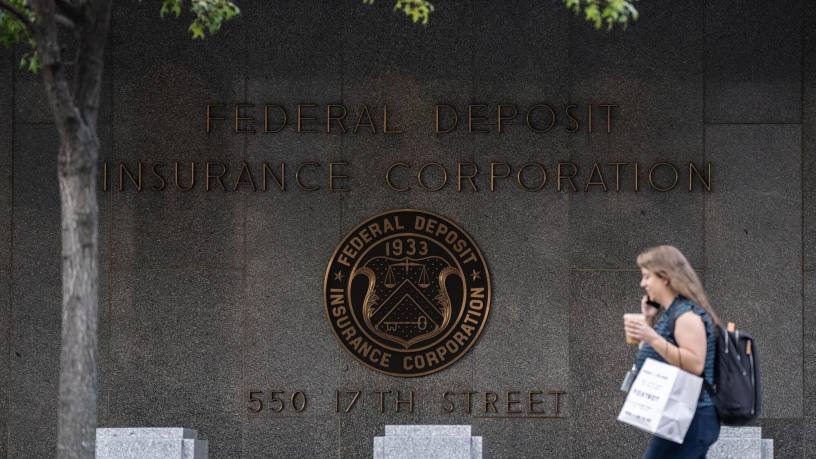US banking groups have criticised last week’s proposals by the Federal Deposit and Insurance Corporation setting tougher conditions for large bank mergers. The proposal, now open for public comments for two months, will make the size of the bank created by a merger a factor in determining which deals come under further scrutiny from the FDIC.
Because the number of banks with total assets of $100bn has grown considerably over the past few decades, the regulator is looking to increase scrutiny of mergers that create such behemoths.
It also foresees a three-year ban on post-merger branch closures for deals which will result in a bank with $100bn or more in assets.
Gregg Rozansky, senior vice-president of advocacy group the Bank Policy Institute, has openly criticised the proposal’s new requirements.
“The FDIC is inventing new obstacles to mergers that have no basis in statute, such as forward-looking representations and commitments around prices, fees, banking services or facility locations,” he said in a statement on March 21, the day the proposal was announced.
The American Bankers Association also questioned the proposal. “We will closely review today’s proposed policy statement and will be prepared to offer our comments, including whether the proposals comply with statutory requirements and enable banks of all sizes and business models to flourish,” it said in a statement on the same day.
For deals resulting in a bank with more than $50bn in assets, the FDIC will hold public hearings for merger applications. Mike Lochmann, partner at law firm Stinson, highlighted that the requirement for public hearings has no statutory basis and is also a “very bad” idea.
“The statute [the Bank Merger Act of 1960] has been around for more than 60 years, and it never even contemplated that you had to have a public hearing — you get written comments that are responded to — but not a public spectacle which this would certainly devolve into if they keep it,” he said.
The proposal also requires applicants to “be prepared to make commitments regarding future retail banking services in the community to be served for at least three years”. In other words, said Lochmann, there will be a ban on post-merger branch closures in that time. Under current regulations, banks can divest assets after a merger, although they still need permission from the regulator to close branches, but now all divestment will have to take place before.
“Divestment has always been an ‘after-the-fact’ move, with banks saying ‘we’ll combine this’, ‘we’ll sell off that line or these branches’. Now they’ll have to complete it before the merger. That’s new,” said Lochmann. The result, he said, will be an approval process that is substantially stretched out.
“Let’s take a fairly large merger that’s negotiated over a period — probably two quarters — then you’ve applied to the regulator. And they’ve come back and said, now you’re going to need to divest. That means you go out and start the process of trying to sell branches, which will take 45 days or 60 days probably to negotiate bids for and then they apply. And that’s another 60 days. So you’ve easily added 120 days to the process,” he said.
Others voice support
Not all industry bodies are critical. The Community Development Bankers Association is backing the proposal
“The CDBA supports the promising updates in the proposal, particularly its focus on community needs. We value the inclusion of measures addressing the impact of branch closings on credit access in low- and moderate-income areas, as these underserved communities frequently bear the brunt of consolidation,” a spokesperson told The Banker.
The CDBA said it anticipates providing feedback to “refine” the final procedures; it will look for such refinements to benefit smaller, mission-driven banks and to foster economic opportunities in urban, rural, minority, native and high-poverty communities.
Ahead of the proposal’s publication, Rohit Chopra, director of the Consumer Financial Protection Bureau, in a speech at the Peterson Institute for International Economics last week, signalled that the CFPB was broadly in favour of the reforms.
Chopra warned that when it came to bank mergers “the rubber stamp is out of ink” and highlighted the “creep of consolidation”. He argued that the FDIC’s policy statement would “bring analytical rigour” to merger review and “better align the agency’s framework with the statute”.
However, Chopra detailed some areas that would benefit from reforms, namely size and growth caps, continuing to reduce the “too big to fail” subsidy and reviewing the exceptions to existing merger prohibitions.
“We should fix the failing bank exception to existing merger prohibitions. For example, under ordinary circumstances, JPMorgan Chase would be ineligible to purchase First Republic Bank, absent this exception. It makes little sense to allow such an acquisition unless there are no other willing bidders or no other means of executing an orderly wind-down,” he said.
Three regulators looking at the issue
Most US bank mergers need approval from three regulators: the FDIC, the Office of the Comptroller of the Currency and the Federal Reserve. The Fed set the threshold at which it conducts a significant review at $100bn in 2017. On January 29, as The Banker reported, the OCC proposed to set a new $50bn threshold above which deals face increased scrutiny.
“It is really noteworthy that the FDIC released a policy statement over a three-to-two vote in an election year without any concurrence by the other two federal banking regulators. They went it alone,” said Lochmann. He stressed that he would have expected a joint release by all three regulators.
“To me it does reflect the idea that the FDIC wants to appear tough on banks. In light of the big failures of a year ago, the FDIC was the one with the insurance fund, they were the ones left holding the bag,” he said.
On March 21, acting comptroller of the currency Michael J. Hsu, speaking for the OCC, said the FDIC proposal was “broadly consistent” with the OCC’s policy statement. He also previously stated that the OCC is working with the Fed, the FDIC and the Department of Justice to update its “analytical framework” related to bank mergers.
Lochmann said he expects even more pushback from banks. “I think there’ll be a lot of comments coming in — and certainly from the bigger banks — saying: ‘You need to co-ordinate better with the other regulators, you should not have different standards’.”
Both the OCC and FDIC proposals arrive against a backdrop of the Biden administration focusing more on preventing mergers that stifle competition. Shortly after taking power in July 2021, President Joe Biden issued an executive order calling on both the DoJ and banking regulators to update guidelines on bank mergers to toughen scrutiny of deals.









